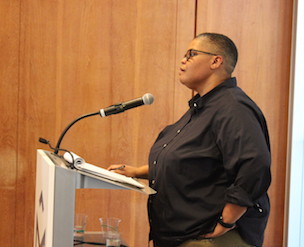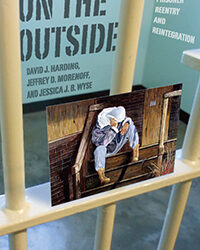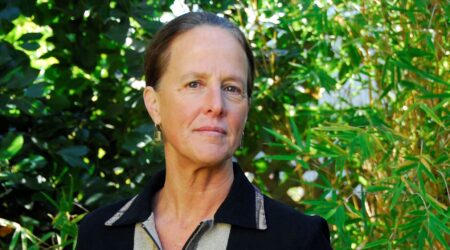On January 24, 2020, Social Science Matrix was honored to host Keeanga-Yamahtta Taylor, Assistant Professor of African American Studies at Princeton University. Professor Taylor discussed her book, Race for Profit: How Banks and the Real Estate Industry Undermined Black Homeownership, which was published in 2019 by University of North Carolina Press and has been longlisted for a National Book Award for nonfiction. The lecture was co-sponsored by the Department of African American Studies, Gender and Women’s Studies, and Global Metropolitan Studies.
 Taylor began her lecture by describing how, in the 1960s, rat infestations were common in Black poor and working-class communities. “In the aftermath of riots in Philadelphia in 1964, a city commissioned report found that one hundred percent of reported rat bites happened in segregated, Black majority neighborhoods,” she said. “Housing segregation—maintained through a vexing combination of white terroristic violence, public policy, and the exclusionary practices of the private sector—insured the dilapidated and substandard condition of Black housing. These were the evidence of exclusion and enclosure and they boiled over into the electricity of successive waves of uprisings across the country.”
Taylor began her lecture by describing how, in the 1960s, rat infestations were common in Black poor and working-class communities. “In the aftermath of riots in Philadelphia in 1964, a city commissioned report found that one hundred percent of reported rat bites happened in segregated, Black majority neighborhoods,” she said. “Housing segregation—maintained through a vexing combination of white terroristic violence, public policy, and the exclusionary practices of the private sector—insured the dilapidated and substandard condition of Black housing. These were the evidence of exclusion and enclosure and they boiled over into the electricity of successive waves of uprisings across the country.”
Poor housing conditions, she explained, were a major driver of riots in Detroit, Los Angeles, and other cities throughout the 1960s, and led the National Advisory Commission on Civil Disorders, known as the Kerner Commission, to call for historic changes to American housing policies. This led to Lyndon Johnson’s Housing and Urban Development Act, which sought to promote single-family homeownership for the poor. “At the heart of the legislation,” Taylor said, “was a low-income homeownership plan that aimed to transform low-income renters into homeowners…. The terms of the new homeownership program were a low $200 down payment, 20 percent of a participant’s income as their mortgage regardless of the cost of the house, and an interest rates capped at one percent. The inclusion of federal mortgage insurance for the first time meant that in the worst-case scenario—foreclosure or abandonment—the federal government was obligated to pay back the mortgage to the lenders. These terms kept the price of the homes manageable for low-income and working-class people.”
Yet this program led to corrupt practices by the real estate industry and banks, Taylor explained, as “speculators and brokers bought up cheap, dilapidated properties hoping to then flip them for higher prices in sales to people who would qualify for the new programs. Not only could money be made by flipping cheap properties, but brokers found it easy to bribe poorly paid FHA appraisers to inflate the value of the houses in the new urban market. Bankers made money on the front end of the real estate deal by securing the loan, and then they made money on the back end with expensive closing costs associated with selling the property. Everyone made money—except the poor Black families that were disproportionately saddled with these broken homes in cities across the country…. In narrowing their focus to ‘access’ alone, racial liberals overlooked the racist practices embedded within those institutions. This was shockingly clear in the real estate industry. Banks and the real estate industry had played a central role in creating the urban housing crisis—exemplified by the persistent presence of rats in Black housing—so the sudden involvement of these same private sector forces was a recipe for disaster.”
 The program failed to remedy racial segregation and income inequality, Taylor said, as many families purchased homes that were in disrepair and had little chance of gaining value over time. “Miserable and dangerous housing conditions in the existing urban market led people to walk away from the homes they had recently purchased, and the numbers of defaults, foreclosures, and FHA insurance payments began to rise,” she said. “Where white housing was seen as an asset developed through inclusion and the accruable possibilities of its surrounding property, Black housing was marked by its exclusion and isolation, where value was extracted, not imbued. These racialized narratives of families, communities, and their built environments reinforced and naturalized the segregative practices among real estate brokers, mortgage bankers, and the white public. Indeed, these perceptions of insurmountable difference steeped in the permanence of blood, race, and culture constituted the underwriting criteria that determined who was to be excluded and who should be included.”
The program failed to remedy racial segregation and income inequality, Taylor said, as many families purchased homes that were in disrepair and had little chance of gaining value over time. “Miserable and dangerous housing conditions in the existing urban market led people to walk away from the homes they had recently purchased, and the numbers of defaults, foreclosures, and FHA insurance payments began to rise,” she said. “Where white housing was seen as an asset developed through inclusion and the accruable possibilities of its surrounding property, Black housing was marked by its exclusion and isolation, where value was extracted, not imbued. These racialized narratives of families, communities, and their built environments reinforced and naturalized the segregative practices among real estate brokers, mortgage bankers, and the white public. Indeed, these perceptions of insurmountable difference steeped in the permanence of blood, race, and culture constituted the underwriting criteria that determined who was to be excluded and who should be included.”
Taylor noted that the trend continued in the 1990s and 2000s, as the rise of subprime lending — and the subsequent market collapse — led to unprecedented home losses for African Americans. “For more than fifty years now, the private sector has been viewed as most capable of ending the persisting urban housing crises,” Taylor explained. “And yet those crises have become even starker over time, creating even greater degrees of housing precariousness. This is especially true in the realm of homeownership…. The recurring perception of ‘risky’ Black buyers has opened pathways for the reemergence of naked, predatory practices in the real estate market. From rent-to-own schemes to the reappearance of LICs in lieu of conventional mortgages, real estate continues to pilfer African Americans in search of their American dream in the housing market. It is not history repeating itself. It is the predictable outcome when the home is a commodity and it continues to be promoted as the fulfillment and meaning of citizenship.”
Watch the full video of the lecture above or on YouTube.


